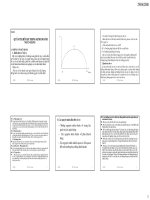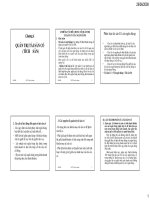slike bài giảng quản trị ngân hàng chương 5 l ending policies and procedures - managing credit risk
Bạn đang xem bản rút gọn của tài liệu. Xem và tải ngay bản đầy đủ của tài liệu tại đây (301.57 KB, 39 trang )
William Chittenden edited and updated the PowerPoint slides for this edition.
CREDIT POLICIES AND
PROCEDURES: MANAGING
CREDIT RISK
Chapter 5
Key topics
1. Types of loans banks make
2. Factors affecting the mix of loans made
3. Regulation of lending
4. Creating a written loan policy
5. Steps in the lending process
6. Loan review and loan workouts
16-2
Types of loans made by banks
Real estate loans
Commercial and industrial loans
Loans to individuals
Financial institution loans
Agriculture loans
Miscellaneous loans
Lease financing receivables
16-3
Loans outstanding for U.S. Banks (2007)
16-4
Factors determining the mix of bank loans
Characteristics of market area: most lenders are
chartered to serve selected markets where they are
located as suburban community (residential real
estate loans, automobile loans, credit for home
appliances) or central city (business loans for
inventory, equipment purchase, business payrolls)
Lender size: legal lending limit to single borrower.
Larger banks → wholesale lenders
Smaller banks → retail credit
16-5
Factors determining the mix of bank loans (cont.)
Experience and expertise of management and
loan policy: commercial banks tend to have
experience and lending policy to make large numbers
of commercial and industrial (business) loans
Expected yield of each type of loan: lenders
prefer to make loans bearing the highest expected
returns (highest net yields: real estate & commercial loans)
Regulations: any loans made are subject to
examination and reviewed and many are restricted or
even prohibited by law.
16-6
Regulation of lending: CAMELS rating system
Capital adequacy
Asset quality
Management quality
Earnings record
Liquidity position
Sensitivity to market risk
16-7
Asset quality
Criticized loans: performing well but lender
have minor weakness
Scheduled loans: containing significant
weakness or showing dangerous
concentration of credit in a borrower/industry
16-8
Asset quality
Adversely classified loans: carrying risk of not
paying out as planned
Substandard loans: margin of protection is
inadequate due to weakness in collateral of the
borrower’s repayment abilities
Doubtful loans: carrying a strong probability of loss
Loss loans: uncollectible or unsuitable to be called
as bankable assets
16-9
Regulators’ use of market forces
Because the quality of examination information
decays very quickly regulators are starting to use
market forces and private market discipline (e.g.
borrowing costs, stock prices) to monitor bank
behavior.
16-10
Quick quiz
1. Why is lending closely regulated by authorities?
2. How loans are classified by risk level in VN? What
is the purpose of loan classification?
3. What is the CAMELS rating and how is it used?
Loan classification
1. Pass/Current: Loans for which borrowers are current in meeting
commitments and for which the full repayment of interest and
principal is not in doubt.
2. Special Mention: Loans with which borrowers are experiencing
difficulties and which may threaten the authorized institution's
position.
3. Substandard: Loans in which borrowers are displaying a definable
weakness that is likely to jeopardise repayment.
4. Doubtful: Loans for which full collection is improbable, the
authorized institution expects to sustain a loss of principal and/or
interest, taking into account net realisable value of collateral.
5. Loss: Loans that are considered uncollectable after all collection
options (such as the realisation of collateral or the institution of legal
proceedings) have been exhausted.
Establishing a good written loan policy
1. Goal statement for bank’s loan portfolio
2. Specification of lending authority of each loan
officer and committee
3. Lines of responsibility in making assignments
and reporting information
4. Operating procedures for soliciting, evaluating
and making loan decisions
5. Required documentation for all loans
6. Lines of authority for maintaining and
reviewing credit files
16-13
Bank’s written loan policy (cont.)
7. Guidelines for taking and perfecting collateral
8. Procedures for setting loan interest rate
9. Statement of quality standards for all loans
10. Statement of upper limit for total loans
outstanding
11. Description of the bank’s principal trade area
12. Procedures for detecting, analyzing and
working out problem loans
16-14
Steps in the lending process
1. Finding prospective loan customers
2. Evaluating a customer’s character and sincerity
of purpose
3. Making site visits and evaluating a customer’s
credit record
4. Evaluating a customer’s financial record
5. Assessing possible loan collateral and signing
the loan agreement
6. Monitoring compliance with the loan agreement
and other customer service needs
16-15
The Six basic C’s of lending
Character – specific purpose of loan and
serious intent to repay loan
Capacity – legal authority to sign binding
contract
Cash – ability to generate enough cash to repay
loan
Collateral – adequate assets to support the loan
Conditions – economic conditions faced by
borrower
Control – does loan meet written loan policy and
how would loan be affected by changing laws
and regulations
16-16
16-17
Common types of loan collateral
Reasons for taking collateral:
Proceeds of collateral sale is to cover loans
Collateralization gives lenders a psychological
advantage over the borrower
The lender’s perfected claim: a lender holds
claim standing superior to claims of other lenders
and the borrower’s own claim.
Procedures for establishing a perfected claim
depends on the nature of assets and laws of the
place where the asset reside.
16-18
Common types of loan collateral
Types of collateral:
Accounts receivables
Factoring
Inventory
Real property
Personal property
Personal guarantees
16-19
Safety zone
Loans exposing to risk should be protected by
1. Deposits maintained by the borrower
2. The borrower’s expected profits, income or
cash flow
3. Strength of the borrower’s balance sheet
liquidity or collateral pledged
4. Personal guarantees and pledges made by a
third party
Information about consumers
Consumer-supplied financial statements
Credit bureau reports
Experience of other lenders
Verification of employment
Verification of property ownership
The web
16-21
Information about businesses
Financial reports supplied by the borrowing firm
Copies of board of director’s resolutions or
partnership agreements
Credit ratings – Dun & Bradstreet, Moody’s,
Standard & Poor’s
New York Times, Wall Street Journal, other
business publications
Risk management associates (RMA), Dun &
Bradstreet industry averages
The world wide web
16-22
Information about governments
Government budget reports
Credit ratings assigned to government
borrowers by Moody’s, Standard & Poor’s,
Fitch
Web
16-23
Lending the old fashioned way? (box)
Traditional lending model
Deregulation of the 1980s and 1990s
New lending model
Financial innovations, such as securitization, and
their effect on lending mix and policies
(“streamlined” loans)
Mortgage market problems, 2007
Newer lending paradigm or back to the basics?
An increased coordination among financial
regulators in different countries
16-24
Quick quiz
1. What is the role of a loan policy to a lending
institutions?
2. What are the differences between Accounts
receivable and Factoring as loan collateral?
3. What are the differences between Personal Property
and Personal guarantees as loan collateral?









